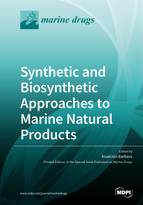Synthetic and Biosynthetic Approaches to Marine Natural Products
A special issue of Marine Drugs (ISSN 1660-3397). This special issue belongs to the section "Synthesis and Medicinal Chemistry of Marine Natural Products".
Deadline for manuscript submissions: closed (8 January 2020) | Viewed by 40323
Special Issue Editor
Interests: heterocyclic chemistry; organosilanes; natural products synthesis; multicomponent reactions
Special Issues, Collections and Topics in MDPI journals
Special Issue Information
Dear Colleagues,
The ocean is the natural habitat for abundant multicellular plants or animals, and unicelular bacteria. These organisms are excellent producers of secondary metabolites with important biological properties. The interesting chemical structures and properties of these marine natural products have attracted the attention of the scientific community, which has made great efforts in the synthesis and biosynthesis of these types of compounds. As Guest Editor of this Special Issue of Marine Drugs, I invite you to provide papers and review articles describing synthetic or biosynthetic approaches to marine natural products. Manuscripts describing total or partial synthesis of marine drugs, as well as analogues, are most welcome.
Prof. Dr. Asunción Barbero
Guest Editor
Manuscript Submission Information
Manuscripts should be submitted online at www.mdpi.com by registering and logging in to this website. Once you are registered, click here to go to the submission form. Manuscripts can be submitted until the deadline. All submissions that pass pre-check are peer-reviewed. Accepted papers will be published continuously in the journal (as soon as accepted) and will be listed together on the special issue website. Research articles, review articles as well as short communications are invited. For planned papers, a title and short abstract (about 100 words) can be sent to the Editorial Office for announcement on this website.
Submitted manuscripts should not have been published previously, nor be under consideration for publication elsewhere (except conference proceedings papers). All manuscripts are thoroughly refereed through a single-blind peer-review process. A guide for authors and other relevant information for submission of manuscripts is available on the Instructions for Authors page. Marine Drugs is an international peer-reviewed open access monthly journal published by MDPI.
Please visit the Instructions for Authors page before submitting a manuscript. The Article Processing Charge (APC) for publication in this open access journal is 2900 CHF (Swiss Francs). Submitted papers should be well formatted and use good English. Authors may use MDPI's English editing service prior to publication or during author revisions.
Keywords
- marine natural products
- total synthesis
- synthesis of analogs
- biosynthesis







